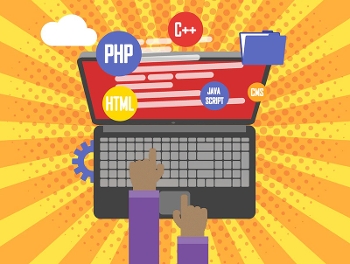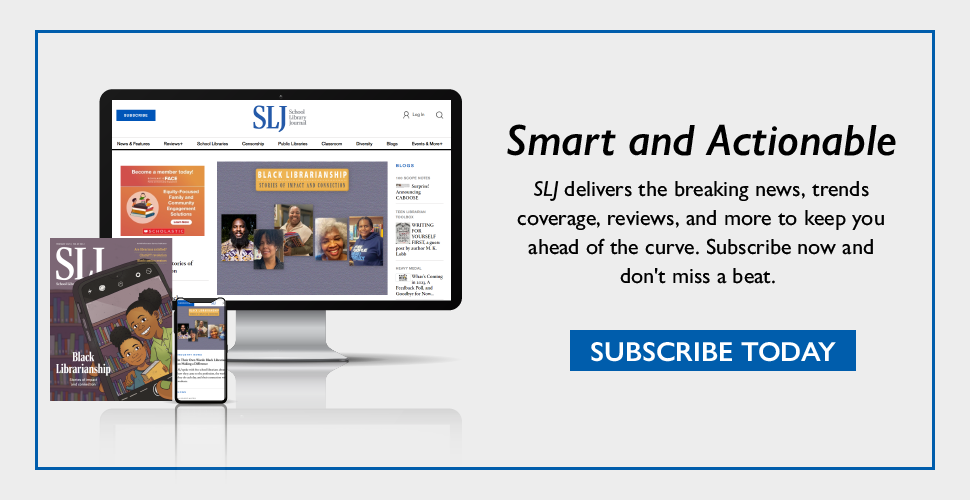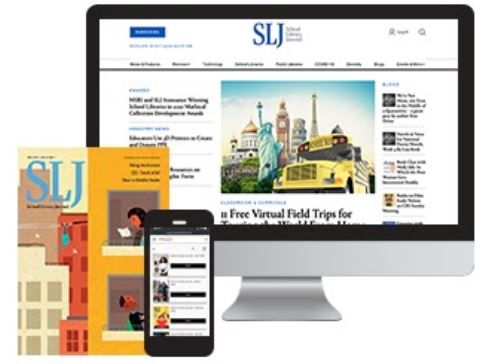Coding Is a Literacy | Opinion
Literacy is the business of librarians. Supporting coding using the pedagogy of maker education is part of our work.
 I’m about to be controversial. Brace yourself, you guys, because I think coding is a language, and because it’s a language, we should be promoting it, teaching it, and advocating for it, as we do for all of the rest of the literacies we support.
I’m about to be controversial. Brace yourself, you guys, because I think coding is a language, and because it’s a language, we should be promoting it, teaching it, and advocating for it, as we do for all of the rest of the literacies we support.
Usually defined as the ability to read and write, literacy is the business of libraries and librarians. Providing access to, advocating for, and sometimes producing text is literally our purpose. Coding is as much a form of literacy as reading novels, picture books, and the Guinness Book of World Records. Supporting it as such, by using the pedagogy of maker education, is a part of our work.
Coding is a body of languages that has similar origins to modern spoken languages.
According to archaeologist Denise Schmandt-Besserat, around 3,000 years ago, Mesopotamians first agreed that a particular mark made a standard sound, and that a group of these marks together had meaning. Writing is humankind’s principal technology for collecting, manipulating, storing, retrieving, communicating, and disseminating information, she notes in her article “The Evolution of Writing.”
Today, too, we use this technology to decode meaning through text, having learned early on that a particular group of squiggles make these noises, and these noises together create meaning. Code, also, is a technology used to collect, manipulate, store, retrieve, communicate, and disseminate information. It, too, is a collection of squiggles that together make meaning.
While it was invented millennia later in human history, code is as useful a language as any other. As languages evolve over time, so too do computer languages. Most computer languages evolve from Fortran (1954), Cobol (1959), and LISP (1958); many spoken languages evolve from Indo-European, Sino-Tibetan, or Afro-Asiatic roots. Spoken languages include nouns and verbs; computer languages have variables and functions. While the syntax and semantics may diverge in use, they remain foundational to all language--whether we are talking to each other or to computers. In other words, computer code is just a group languages like any other languages with similar intent, structure and purpose. Though code isn’t spoken like other languages, it is still a language. No one speaks Latin, either.
A coding “library of things”
School librarians are especially pivotal in coding literacy because, as with any other language, the age of acquisition for any language matters. Librarians are uniquely placed in schools with students from their early years, long before children have access to computer science electives. According to Andrea Mechelli's 2004 study "Structural Plasticity in the Bilingual Brain," second language acquisition literally changes how a person’s brain is structured. Learning second languages leads to stronger, more flexible brains, and the earlier the language is acquired, the better, as noted by Miao Wei in 2015 his article "How age of acquisition influences brain architecture in bilinguals." Learning to code, like acquiring any language, can literally enlarge our students’ brains. And, as librarians, we are perfectly situated to advocate for this literacy.
I know that approaching a new literacy requires some bravery. To support it, a library may need to reconsider two pivotal levers in our programs: collection building and instruction.
Libraries support and reflect their own communities. As we develop our collections around second languages, it should be not only about buying books in Spanish or Urdu, but also around the language of code. A balanced collection would also include the tools that students may need to become more literate in coding.
Just as we build our book collections around our students, so should we build our coding collection. Leveled tools from Ozobots to Arduinos should be part of our collections in a library of things that supports coding literacy. Ozobots, Spheros, and Code-a-pillars would be more appropriate to elementary collections, while Hummingbirds and LEGO Mindstorms would build a solid foundation in middle school for the VEX robotics used in competitive high school and university robotics.
As the digital age marches forward, many of our book collections are either digitized or born digital. Taking advantage of those born-digital tools to build a collection that supports the literacy of code. For example, BlocksCAD is a program that bridges several states of matter—both digital and not. Using BlocksCAD, students can use code to create geometric forms on a coordinate plane. Once coded, this geometric form can be printed using a 3-D printer, bridging the gap between virtual and actual. Students effectively use your collection and their own literacy to create reality.
Just let that settle in for a moment, because it is wild. Students can make their own reality by learning to read and write code.
In promoting literacy, we know that the most beautiful collection is just a dust magnet without instruction. For those building a library collection that advocates for all literacies, Maker Education provides a path for students and for librarians to work with code.
Maker Education is a pedagogy that has been widely used in school libraries internationally. It blends many popular structures, such as design cycles, project-based learning, and computational thinking. As such, it’s helpful to use as a pedagogy as we promote the literacy of code alongside traditional literacy.
According to MakerEd, “Building on the work of educational theorists like Jean Piaget (constructivism) and Seymour Papert (constructionism) maker-centered learning develops that awareness through interactive, open-ended, student-driven, multi-disciplinary experiences that allow for the time and space needed to develop diverse skills, knowledge, and ways of thinking.” While many of us have had or have been developing maker programs over the course of the last decade, understanding the lines of what constitutes “maker” versus “craft” or “activity” is sometimes a thin line. In my thinking, that line has to do with intent. My intent is usually focused on literacy.
Still founded on those constructivism principles and designed as “interactive, open-ended, student-driven, multi-disciplinary experiences,” according to MakerEd, maker projects are often focused on reading, writing, speaking, or listening in all the myriad forms that takes.
The sixth grade math classes at Burley (VA) Middle School, where I was a librarian from 2016-20, engaged in a semester-long maker project each spring. Each Friday, the students met to solve a problem using code. Working in groups, students would start in the same way we begin teaching them to read English: we looked at the other programs to learn about the structure of the one we’re studying. We “read” a program first dissecting it and understand how it was structured. Scratch, for instance, has an easy, “look inside” button that can show students of any coding level how the game is made and we took full advantage.
Then we moved onto the code equivalent of picture books in the form of block coding. We used Scratch to teach students how to interact with 2-D code. It provided them a way to easily move individual commands and blocks of code around to create a functional program. It worked along the same principle we use to teach little ones how to move words around in a sentence in order to achieve communication. In this case, the communication was making the cat spin around and meow in Scratch.
Having achieved some facility in block coding, we moved onto the equivalent of our first chapter book: a Hummingbird. Hummingbirds are a microcontrollers, like an Arduino that uses Scratch to run motors and blink lights. Students continued using the building blocks provided by Scratch to code a machine that worked in real life. Their excitement looked just like the sparkle my daughter had when she brought home her first chapter book. It was a whole new world of literacy.
Scratch is limited in what it can achieve with a Hummingbird, so our students moved ahead with our coding literacy and scripting. Using the Arduino microcontrollers, our students took their knowledge of the semantics and syntax of code to solve a problem, leveraging their literacy to successfully communicate with a machine.
Communication comes in many forms; Increasingly, it is written in computer code. While some students learn to code in computer science class or math, the library is one of the best places for students to explore coding because the library is a uniquely democratic place in schools and because, fundamentally, coding and computational thinking are literacy.
The constructivist format defined in the maker education pedagogy provides a pathway for non-coder librarians to support students’ learning. As librarians, we promote access to literacy to all our students and all our students deserve our support for the literacy of code.
IdaMae Craddock is the librarian at the Albemarle (VA) Lab Schools.
RELATED
The job outlook in 2030: Librarians will be in demand
The job outlook in 2030: Librarians will be in demand
ALREADY A SUBSCRIBER? LOG IN
We are currently offering this content for free. Sign up now to activate your personal profile, where you can save articles for future viewing






Add Comment :-
Comment Policy:
Comment should not be empty !!!
Amanda Mitchell
Hi Mae! We attended the ODU Library Science program together, and I just noticed your article in an email from SLJ and gasped out loud to see your name! You are doing such an excellent job in the field, and I'm proud to know you. This is an amazing article and I 100% agree with you!! It is definitely a new part of literacy and I look forward to learning more about it myself and encouraging my students to learn as well. Thank you so much for your insights on this. :)
Posted : Sep 10, 2020 12:58